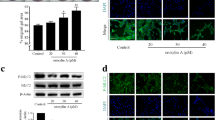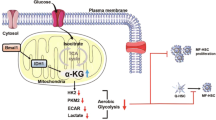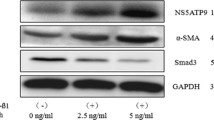Abstract
Hepatic stellate cells (HSCs) activation is a key step that promotes hepatic fibrosis. Emerging evidence suggests that aerobic glycolysis is one of its important metabolic characteristics. Our previous study has reported that CD147, a glycosylated transmembrane protein, contributes significantly to the activation of HSCs. However, whether and how it is involved in the aerobic glycolysis of HSCs activation is unknown. The objective of the present study was to validate the effect of CD147 in HSCs activation and the underlying molecular mechanism. Our results showed that the silencing of CD147 decreased the expression of α-smooth muscle-actin (α-SMA) and collagen I at both mRNA and protein levels. Furthermore, CD147 silencing decreased the glucose uptake, lactate production in HSCs, and repressed the lactate dehydrogenase (LDH) activity, the expression of hexokinase 2 (HK2), glucose transporter 1 (Glut1). The effect of galloflavin, a well-defined glycolysis inhibitor, was similar to CD147 siRNA. Mechanistically, CD147 silencing suppressed glycolysis-associated HSCs activation through inhibiting the hedgehog signaling. Moreover, the hedgehog signaling agonist SAG could rescue the above effect of CD147 silencing. In conclusion, CD147 silencing blockade of aerobic glycolysis via suppression of hedgehog signaling inhibited HSCs activation, suggesting CD147 as a novel therapeutic target for hepatic fibrosis.




Similar content being viewed by others
References
Ban D, Hua S, Zhang W, Shen C, Miao X, Liu W (2019) Costunolide reduces glycolysis-associated activation of hepatic stellate cells via inhibition of hexokinase-2. Cell Mol Biol Lett 24:1
Bataller R, Brenner DA (2005) Liver fibrosis. J Clin Investig 115:209–218
Chen Y, Choi SS, Michelotti GA, Chan IS, Swiderska-Syn M, Karaca GF, Xie G, Moylan CA, Garibaldi F, Premont R et al (2012) Hedgehog controls hepatic stellate cell fate by regulating metabolism. Gastroenterology 143:1319–1329
Choi SS, Omenetti A, Syn W-K, Diehl AM (2011) The role of Hedgehog signaling in fibrogenic liver repair. Int J Biochem Cell Biol 43:238–244
Ding H, Jiang L, Xu J, Bai F, Zhou Y, Yuan Q, Luo J, Zen K, Yang J (2017) Inhibiting aerobic glycolysis suppresses renal interstitial fibroblast activation and renal fibrosis. Am J Physiol Renal Physiol 313:F561–F575
Ebrahimi H, Naderian M, Sohrabpour AA (2016) New concepts on pathogenesis and diagnosis of liver fibrosis; a review article. Middle East J Dig Dis 8:166–178
Feng J, Wang CF, Liu T, Li JJ, Wu LW, Yu Q, Li SN, Zhou YT, Zhang J, Chen JJ et al (2019) Procyanidin B2 inhibits the activation of hepatic stellate cells and angiogenesis via the Hedgehog pathway during liver fibrosis. J Cell Mol Med 23:6479–6493
Gao W, Sun J, Wang F, Lu Y, Wen C, Bian Q, Wu H (2019) Deoxyelephantopin suppresses hepatic stellate cells activation associated with inhibition of aerobic glycolysis via hedgehog pathway. Biochem Biophys Res Commun 516:1222–1228
Ge X, Lyu P, Gu Y, Li L, Li J, Wang Y, Zhang L, Fu C, Cao Z (2015) Sonic hedgehog stimulates glycolysis and proliferation of breast cancer cells Modulation of PFKFB3 activation. Biochem Biophys Res Commun 464:862–868
Guy CD, Suzuki A, Zdanowicz M, Abdelmalek MF, Burchette J, Unalp A, Diehl AM (2012) Hedgehog pathway activation parallels histologic severity of injury and fibrosis in human nonalcoholic fatty liver disease. Hepatology 55:1711–1721
Hu L, Lin X, Lu H, Chen B, Bai Y (2015) An overview of hedgehog signaling in fibrosis. Mol Pharmacol 87:174–182
Hu ZQ, Li L, Ran JH, Chu G, Gao HQ, Guo LC, Chen JP (2019) miR-125b acts as anti-fibrotic therapeutic target through regulating Gli3 in vivo and in vitro. Ann Hepatol 18:825–832
Huang S, Chang SJ, Yang M, Chen JJ, Chang WH (2011) Nanoscale hepatoprotective herbal decoction attenuates hepatic stellate cell activity and chloroform-induced liver damage in mice. Int J Nanomed 6:1365–1371
Huang Q, Li J, Xing J, Li W, Li H, Ke X, Zhang J, Ren T, Shang Y, Yang H et al (2014) CD147 promotes reprogramming of glucose metabolism and cell proliferation in HCC cells by inhibiting the p53-dependent signaling pathway. J Hepatol 61:859–866
Huang P, Mao LF, Zhang ZP, Lv WW, Feng XP, Liao HJ, Dong C, Kaluba B, Tang XF, Chang S (2018) Down-regulated miR-125a-5p promotes the reprogramming of glucose metabolism and cell malignancy by increasing levels of CD147 in thyroid cancer. Thyroid 28:613–623
Kim J, Hyun J, Wang S, Lee C, Lee JW, Moon EY, Cha H, Diehl AM (2017) Thymosin beta-4 regulates activation of hepatic stellate cells via hedgehog signaling. Sci Rep 7:3815
Li X-b, Gu J-d, Zhou Q-h (2015a) Review of aerobic glycolysis and its key enzymes - new targets for lung cancer therapy. Thoracic Cancer 6:17–24
Li HY, Ju D, Zhang DW, Li H, Kong LM, Guo Y, Li C, Wang XL, Chen ZN, Bian H (2015b) Activation of TGF-beta1-CD147 positive feedback loop in hepatic stellate cells promotes liver fibrosis. Sci Rep 5:16552
Lian N, Jiang Y, Zhang F, Jin H, Lu C, Wu X, Lu Y, Zheng S (2015) Curcumin regulates cell fate and metabolism by inhibiting hedgehog signaling in hepatic stellate cells. Lab Investig 95:790–803
Lian N, Jin H, Zhang F, Wu L, Shao J, Lu Y, Zheng S (2016) Curcumin inhibits aerobic glycolysis in hepatic stellate cells associated with activation of adenosine monophosphate-activated protein kinase. IUBMB Life 68:589–596
Liu XY, Liu RX, Hou F, Cui LJ, Li CY, Chi C, Yi E, Wen Y, Yin CH (2016) Fibronectin expression is critical for liver fibrogenesis in vivo and in vitro. Mol Med Rep 14:3669–3675
Lv F, Li N, Kong M, Wu J, Fan Z, Miao D, Xu Y, Ye Q, Wang Y (2020) CDKN2a/p16 Antagonizes Hepatic Stellate Cell Activation and Liver Fibrosis by Modulating ROS Levels. Front Cell Dev Biol 8:176
Ohyama T, Sato K, Kishimoto K, Yamazaki Y, Horiguchi N, Ichikawa T, Kakizaki S, Takagi H, Izumi T, Mori M (2012) Azelnidipine is a calcium blocker that attenuates liver fibrosis and may increase antioxidant defence. Br J Pharmacol 165:1173–1187
Philips GM, Chan IS, Swiderska M, Schroder VT, Guy C, Karaca GF, Moylan C, Venkatraman T, Feuerlein S, Syn W-K et al (2011) Hedgehog signaling antagonist promotes regression of both liver fibrosis and hepatocellular carcinoma in a murine model of primary liver cancer. PLoS ONE 6:e23943
Rodríguez-García A, Samsó P, Fontova P, Simon-Molas H, Manzano A, Castaño E, Rosa JL, Martinez-Outshoorn U, Ventura F, Navarro-Sabaté À et al (2017) TGF-α1 targets Smad, p38 MAPK, and PI3K/Akt signaling pathways to induce PFKFB3 gene expression and glycolysis in glioblastoma cells. FEBS J 284:3437–3454
Shen JY, Yan JY, Wei XZ, Liu ZP, Ni J, Hu BW, Jin LF (2020) Gant61 ameliorates CCl4-induced liver fibrosis by inhibition of Hedgehog signaling activity. Toxicol Appl Pharmacol 387:114853
Shimada H, Staten NR, Rajagopalan LE (2011) TGF-α1 mediated activation of Rho kinase induces TGF-α2 and endothelin-1 expression in human hepatic stellate cells. J Hepatol 54:521–528
Sicklick JK, Li YX, Choi SS, Qi Y, Chen W, Bustamante M, Huang JW, Zdanowicz M, Camp T, Torbenson MS et al (2005) Role for Hedgehog signaling in hepatic stellate cell activation and viability. Lab Investig 85:1368–1380
Swiderska-Syn M, Suzuki A, Guy CD, Schwimmer JB, Abdelmalek MF, Lavine JE, Diehl AM (2013) Hedgehog pathway and pediatric nonalcoholic fatty liver disease. Hepatology 57:1814–1825
Thayer SP, di Magliano MP, Heiser PW, Nielsen CM, Roberts DJ, Lauwers GY, Qi YP, Gysin S, Fernández-del Castillo C, Yajnik V et al (2003) Hedgehog is an early and late mediator of pancreatic cancer tumorigenesis. Nature 425:851–856
Tsuchida T, Friedman SL (2017) Mechanisms of hepatic stellate cell activation. Nat Rev Gastroenterol Hepatol 14:397–411
Wang C, Silverman RM, Shen J, O’Keefe RJ (2018) Distinct metabolic programs induced by TGF-α1 and BMP2 in human articular chondrocytes with osteoarthritis. J Orthop Transl 12:66–73
Wang F, Jia Y, Li M, Wang L, Shao J, Guo Q, Tan S, Ding H, Chen A, Zhang F et al (2019) Blockade of glycolysis-dependent contraction by oroxylin a via inhibition of lactate dehydrogenase-a in hepatic stellate cells. Cell Commun Signal 17:11
Weiskirchen R, Tacke F (2016) Liver fibrosis: from pathogenesis to novel therapies. Dig Dis (Basel, Switzerland) 34:410–422
Weng HL, Liu Y, Chen JL, Huang T, Xu LJ, Godoy P, Hu JH, Zhou C, Stickel F, Marx A et al (2009) The etiology of liver damage imparts cytokines transforming growth factor beta1 or interleukin-13 as driving forces in fibrogenesis. Hepatology 50:230–243
Wu J, Ru NY, Zhang Y, Li Y, Wei D, Ren Z, Huang XF, Chen ZN, Bian H (2011) HAb18G/CD147 promotes epithelial-mesenchymal transition through TGF-beta signaling and is transcriptionally regulated by Slug. Oncogene 30:4410–4427
Yan JY, Huang HR, Liu ZP, Shen JY, Ni J, Han JW, Wang RJ, Lin DR, Hu BW, Jin LF (2020) Hedgehog signaling pathway regulates hexavalent chromium-induced liver fibrosis by activation of hepatic stellate cells. Toxicol Lett 320:1–8
Zhang YF, Liu JJ, Sun YC, Yu XZ, Wang J, Dai D, Zhu YJ, Song XY, Zhu L, Li XF et al (2020) Enhanced glucose metabolism mediated by CD147 is associated with F-18-FDG PET/CT imaging in lung adenocarcinoma. Thoracic Cancer 11:1245–1257
Zheng X, Han H, Liu G-P, Ma Y-X, Pan R-L, Sang L-J, Li R-H, Yang L-J, Marks JR, Wang W et al (2017) LncRNA wires up Hippo and Hedgehog signaling to reprogramme glucose metabolism. Embo J 36:3325–3335
Acknowledgements
This work was supported by grants from the National Natural Science Fund of China (Grant No. 81700546),Scientific Research Project of Xi’an Medical University (Grant Nos. 2017PT13; 2018PT68), Key Research Project in Shaanxi Province (Grant Nos. 2018SF-168; 2020SF-349), Natural Science Basic Research Program of Shaanxi (Grant No. 2019JQ-886), National Science and Technology Fund research Program of Xi’an Medical University (Grant No. 2017GFY18).
Author information
Authors and Affiliations
Corresponding author
Ethics declarations
Conflict of interest
The authors declare no conflicts of interest.
Additional information
Publisher’s note
Springer Nature remains neutral with regard to jurisdictional claims in published maps and institutional affiliations.
Supplementary Information
Below is the link to the electronic supplementary material.
10616_2021_460_MOESM1_ESM.tif
Supplemental Fig. 1. CD147 is overexpressed in activated HSCs, and CD147 silencing inhibits the HSCs activation. Measurement of CD147, α-SMA, collagen protein levels (A) in HSC-T6 cells stimulated with various doses of TGF-β1 by western blots. The protein levels of CD147 knocked down by 2 different siRNAs were measured in LX-2 (B) and HSC-T6 (C) cells by western blots. Measurement protein levels of CD147 (D) in si-CD147 treated HSC-T6 cells exposed to 4ng/ml TGF-β1Supplemental Fig. 1. CD147 is overexpressed in activated HSCs, and CD147 silencing inhibits the HSCs activation. Measurement of CD147, α-SMA, collagen protein levels (A) in HSC-T6 cells stimulated with various doses of TGF-β1 by western blots. The protein levels of CD147 knocked down by 2 different siRNAs were measured in LX-2 (B) and HSC-T6 (C) cells by western blots. Measurement protein levels of CD147 (D) in si-CD147 treated HSC-T6 cells exposed to 4ng/ml TGF-β1 (TIF 887 kb)
10616_2021_460_MOESM2_ESM.tif
Supplemental Fig. 2. CD147 silencing inhibits the HSCs activation through suppressing aerobic glycolysis. TGF-β1, si-CD147, and/or galloflavin(a lactate dehydrogenase inhibitor) were applied to HSC-T6 cells at indicated concentrations for 24 h. A. Measurement of α-SMA, collagen I protein levels by western blots. B. Measurement of HK2, Glut1 protein levels by western blots (TIF 258 kb)
10616_2021_460_MOESM3_ESM.tif
Supplemental Fig. 3. Silencing of CD147 inhibits Hedgehog signaling in activated HSCs. TGF-β1,si-CD147, and/or SAG (a Hedgehog signaling activator) were applied to HSC-T6 cells at indicated concentrations for 24 h. Western blots analyses of protein levels of Patched, Smo, and Hhip (TIF 563 kb)
Rights and permissions
About this article
Cite this article
Li, H., Yang, L., Sun, Y. et al. Silencing of CD147 inhibits hepatic stellate cells activation related to suppressing aerobic glycolysis via hedgehog signaling. Cytotechnology 73, 233–242 (2021). https://doi.org/10.1007/s10616-021-00460-9
Received:
Accepted:
Published:
Issue Date:
DOI: https://doi.org/10.1007/s10616-021-00460-9




